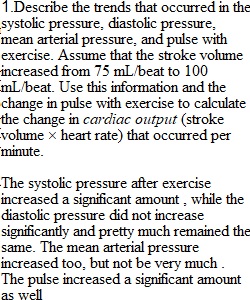


Q 1. 1. Describe the trends that occurred in the systolic pressure, diastolic pressure, mean arterial pressure, and pulse with exercise. Assume that the stroke volume increased from 75 mL/beat to 100 mL/beat. Use this information and the change in pulse with exercise to calculate the change in cardiac output (stroke volume ? heart rate) that occurred per minute. 2.2. Pulse pressure is the difference between systolic pressure (peak pressure during active contraction of the ventricles) and diastolic pressure (the pressure that is maintained even while the left ventricle is relaxing). Describe the change in pulse pressure seen with exercise. Which component of the blood pressure is most responsible for this change? 3. A change in pulse pressure can be seen in a variety of medical conditions. What would you expect to happen to the pulse pressure in the following examples? (a) In atherosclerosis there is a hardening of the arterial walls. (b) A damaged aortic valve does not seal properly and allows blood to flow back into the ventricle during diastole.
View Related Questions